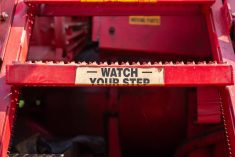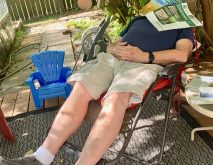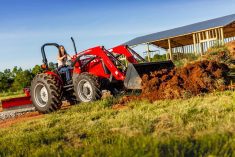As her 80th birthday approaches, a farm widow we’ll call Mary finds herself in a dilemma. Her husband Bob passed away 10 years ago, leaving substantial life insurance benefits which she used to cover living expenses and farm losses. Mary’s 1,280-acre grain farm is rented to tenants. The farm has broken even with recent high grain prices and there’s a gravel pit on one section.
Mary’s problem is to ensure that her four children, two of whom are farmers, are treated equally. There are also seven grandchildren who will have post-secondary educational expenses. She would like to donate some land to a conservation foundation and some money to her church.
Read Also

Gentle treatments for pain in the neck
Heading toward year-end, people unknowingly tense up against the cold and busyness, causing neck pain that can often be treated with appropriate support and gentle mobility, athletic therapist Kathlyn Hossack says.
The farm has a turbulent history. Low grain prices for much of the 1960s, rising operating costs in the 1970s, then high interest rates in the 1980s made the farm a subsistence operation for decades. For the last half-dozen years, the farm has broken even, but Mary now realizes she has to sell it. She has already sold the machinery and inventory. What’s left is eight quarters, one with the gravel pit that’s sold off 75 per cent of its estimated rock.
Mary wants to move to an assisted living apartment in a nearby town. To do that, she will need about $45,000 a year in after-tax income.
Farm Financial Planner asked Rod Tyler, head of the Tyler Group in Regina, to work with Mary to devise a plan for transitioning the farm to cash for her children and for her own future. She already has financial assets worth $838,000 from Bob’s life insurance and decades of modest living and saving.
At present, five quarters of land are rented to two sons who farm it. The rent supports Mary’s cost of living. Two other quarters are rented to a third party. Total rental income averages $50 per acre per year, though she rents at a 20 per cent discount to her farming sons.

The plan
Mary would like to sell the five quarters to her farming sons at a discounted price, enabling them to finance at today’s low interest rates. She expects to sell the other two quarters for their assessed value on the open market, obtaining enough to provide equal sums of about $325,000 to each child, pay any capital gains tax due after application of the $800,000 capital gains exemption for qualified farm property and then donate the single quarter with the gravel pit to a charity for use as a wildlife refuge. The charity would provide a tax receipt for the value. Mary might wind up paying the Alternative Minimum Tax for one year. The AMT paid would be a carryforward for future taxes due, so its net cost could be zero. In the year of the sale, she would probably have income far in excess of the Old Age Security clawback point at which all OAS is lost. But it would be for only one year.
Assuming that Mary sells her farmland, donates the quarter to a charity, gives the proceeds to her four children, sells her home for $200,000 but retains her financial assets, she will have total assets for investment of $1,038,000. A three per cent return would produce annual pre-tax income of $31,140. On top of that base income, she would have Old Age Security benefits of $6,840 in 2015 dollars, and CPP benefits of $4,500 a year. Her total income would be $42,480. After 15 per cent average income tax, she would have income of $3,000 a month.
Mary can raise her investment income by using an annuity payout method. It is a calculation of return of capital, some of which is not taxed. It is not the result of buying an annuity from an insurance company. Using an annuity that would exhaust all capital in 20 years to her age 100, she could have $67,740. OAS and CPP would push annual income to $79,080. Allowing for a return of capital adjustment in her tax preparation, she could squeak by the clawback, which starts at $72,809 in 2016, and retain all of her income.
That would be in excess of her needs in a range of $40,000 to $50,000 a year, the higher sum reflecting perhaps costs of travel to see her grandchildren, gifts to them, a winter holiday and other pleasures. The excess income could be banked or just given to her family or to good causes, the latter with tax receipts.
There are other simple moves Mary can make to generate income and reduce tax. First, and most obvious, is to open a Tax-Free Savings Account. Under 2015 rules that do not reflect new moves by the federal government to reduce TFSA contribution space, Mary could shelter $41,000 and reduce her taxable income, using the three per cent rate of return, by $1,230 a year. She could also top up the Registered Education Savings Plans of her grandchildren. Each move would reduce present taxable income.
Mary’s substantial financial assets should be moved to professional management, Tyler suggests. Fee-only planners will handle the chore for about one to 1.5 per cent of assets under management. That would save her as much as 1.5 per cent of average fees charged by equity mutual funds. If she wishes to use mutual funds, corporate class units that can be swapped within the class umbrella without tax would reduce tax bills. There are guaranteed income funds with tax advantages, but the high internal fees of these structures makes them unsuitable for Mary.
Above all, Mary should move the $590,000 she holds in cash and GICs to more profitable uses. A portfolio of stocks with a history of raising dividends would be appropriate. A modest allocation, about 10 per cent, to investment grade corporate bonds and government bonds, would provide a cushion if the world economy and Canada’s economy should go into serious recession and deflation. Those bonds, with fixed and assured payments, would rise in price and continue to provide income even if stock dividends were cut. For every one per cent gain in return, which even bonds would provide in comparison to the large cash position Mary holds, her financial assets would provide an additional $10,000 of pre-tax income.
“Mary’s decades of hard work and her dedication to her family can be preserved through this land allocation and investment plan,” Tyler says.














